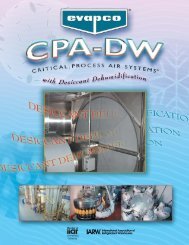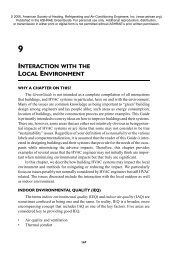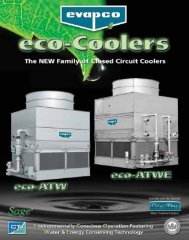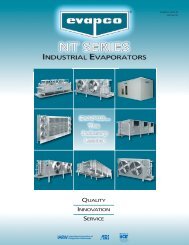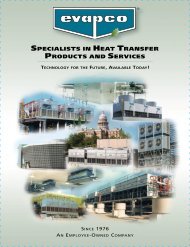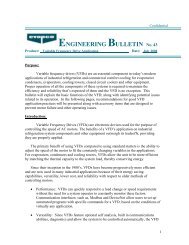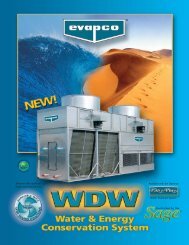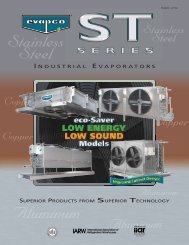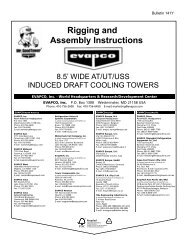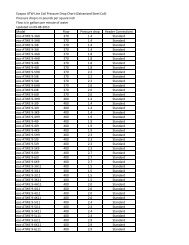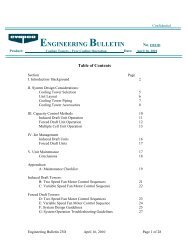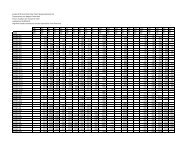The Use of Variable Frequency Drives Engineering Bulletin
The Use of Variable Frequency Drives Engineering Bulletin
The Use of Variable Frequency Drives Engineering Bulletin
Create successful ePaper yourself
Turn your PDF publications into a flip-book with our unique Google optimized e-Paper software.
Specific Applications <strong>of</strong> the VFD<br />
Cooling Tower Performance with a <strong>Variable</strong> <strong>Frequency</strong> Drive<br />
Because <strong>of</strong> the increasing number <strong>of</strong> VFD applications, the question <strong>of</strong> capacity and power<br />
consumption at low fan speed is frequently asked. For estimating purposes,<br />
the unit capacity drops <strong>of</strong>f linearly with fan speed and fan power is reduced by the cube <strong>of</strong> fan<br />
speed.<br />
For example, if a unit produces 500 tons with a 50 hp fan motor at full speed, it will produce<br />
250 tons at half speed. According to the fan laws, the unit will draw (.5) 3 =.125 x 50 HP=6.25<br />
HP . Due to inefficiencies at low speed the motor will actually draw 7.5 HP.<br />
(15% instead <strong>of</strong> 12.5% <strong>of</strong> full speed nameplate hp). If more accurate data is required for<br />
less than full speed performance, contact the EVAPCO Marketing department.<br />
NOTE: <strong>The</strong> recommended minimum cut-<strong>of</strong>f speed for VFD belt or gear applications for<br />
1800 rpm motors is 25% (30% for 1500 rpm gear drive and 35% for 1200 rpm gear<br />
drive). Speeds below these minimums may result in motor cogging and torque ripple,<br />
and in some gear drive systems, reduced lubrication capability. Operating at very low<br />
speed leads to excessive drive vibration and excitation <strong>of</strong> the tower’s low structural<br />
resonant frequencies. Most VFD manufacturers are now providing good low speed<br />
motor control, but problems do develop and will be most evident in the lower speed<br />
operation.<br />
Free Cooling and Winter Operation-Reverse Fan Operation at Half-Speed<br />
EVAPCO’s Induced Draft Cooling Towers are designed for year around operation. During<br />
free cooling and winter operation, ice may develop in the cooling tower. On induced-draft<br />
cooling towers, a reverse mode can be applied to de-ice the cooling tower. <strong>The</strong> VFD supplied<br />
on such projects should be designed with a reverse mode. <strong>The</strong> reverse mode must be locked<br />
out to operate at or below 50% <strong>of</strong> motor rpm only, any higher fan speed may damage the fill<br />
and eliminators.<br />
Also, during free cooling/winter operation mode, the tower fan speed should be ideally set to<br />
cycle between 50% and 100% fan speed. Operating below 50% fan speed may allow water to<br />
come into contact with the inlet louvers and start ice formation.<br />
EVAPCO’s Forced Draft Cooling towers utilized in free cooling and winter operation will<br />
have a different control scheme. It is NOT possible to operate the centrifugal fan in reverse for<br />
de-icing. For these applications, it is essential to have a VFD that is programmed to operate<br />
down to 10% to allow the fans to always operate and reduce the possibility <strong>of</strong> splash-out and<br />
condensation on the fans, which lead to ice build up.<br />
Gear <strong>Drives</strong> and VFD’s-Gear Drive Chatter and Minimum Input RPM<br />
Gear Drive Chatter<br />
VFD’s can have a negative impact on the mechanical performance <strong>of</strong> gear drive systems.<br />
4



